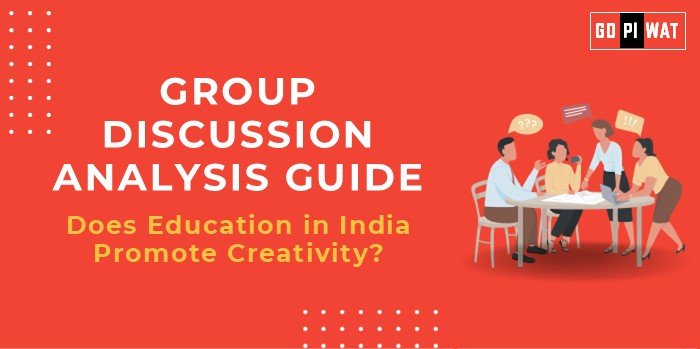📋 GD Analysis: Does Education in India Promote Creativity?
🌐 Introduction to Education and Creativity in India
📖 In today’s rapidly evolving global landscape, creativity and innovation are essential for economic and social progress. The debate around whether the Indian education system fosters or stifles creativity is a crucial topic for understanding India’s potential for future growth and adaptability.
India’s education system, rooted in historical academic traditions, has long emphasized rote learning and standardized testing. While recent reforms like the National Education Policy (NEP) 2020 aim to address these issues, challenges persist in transforming educational practices nationwide.
📊 Quick Facts and Key Statistics
- 📘 NEP 2020 Initiatives: Encourages experiential, activity-based learning with arts and sports integration to foster creativity.
- 🏢 Corporate Demand: A survey shows that 100% of corporates consider creative thinking critical for recruitment.
- 👨👩👧 Parental Perception: 59% of parents believe the current education system does not adequately foster creativity, while 96% feel schools should play a more active role.
- 🏫 Institution Innovation Councils: India has set up 7,265 IICs and 106 IDEA Labs to support creative projects in higher education.
- 🎨 Student Creativity Levels: Only 10% of students feel they reach their creative potential in classrooms, indicating a disconnect between goals and experiences.
🤝 Stakeholders and Their Roles
- 🏛️ Government: Develops policies like NEP 2020 to encourage holistic development and creative learning.
- 🏫 Educational Institutions: Curriculum design and evaluation methods directly influence the extent of creativity fostered in classrooms.
- 👨👩👧👦 Parents: Socio-economic factors often guide career choices, sometimes prioritizing stability over creativity.
- 🎓 Students: Balance academic performance with creative pursuits, directly affected by the system’s approach.
- 💻 Private Ed-Tech Firms: Provide supplementary creative learning programs and introduce new-age skills.
🎯 Achievements and Challenges
🌟 Achievements:
- 📜 Policy Reforms: NEP 2020 emphasizes experiential learning and critical thinking.
- 🎨 Creative Programs: Schools are increasingly introducing coding, arts, and design thinking to foster creativity.
- 🌍 International Collaborations: Exchange programs with global universities introduce creative learning techniques.
⚠️ Challenges:
- 📚 Rote Learning: Persistent reliance on memorization and test-based evaluations limits creativity.
- 🏚️ Resource Gaps: Many schools lack infrastructure and trained educators to teach creatively.
- 🧑💼 Social Pressure: Societal expectations often prioritize high-paying careers over creative fields.
🌍 Global Comparisons
- 🇫🇮 Finland: Focuses on creativity and problem-solving over standardized testing, achieving higher PISA rankings.
- 🇸🇬 Singapore: Emphasizes experiential and skills-based education, integrating creativity into its curriculum.
📖 Case Study:
Delhi’s “Happiness Curriculum” aims to reduce academic pressure and boost emotional well-being, fostering creativity and critical thinking.
📄 Structured Arguments for Discussion
🔹 Supporting Stance: “India’s education reforms, such as the NEP 2020, are paving the way for creativity by incorporating skill-based learning and critical thinking.”
🔹 Opposing Stance: “Despite policy changes, the deep-rooted emphasis on rote learning and standardized testing in India limits genuine creativity.”
🔹 Balanced Perspective: “While reforms are underway to promote creativity, India’s education system faces challenges that require gradual but determined shifts in teaching practices and cultural mindset.”
📊 Effective Discussion Approaches
- 📈 Data-Centric Start: “With over 85% of students under academic pressure, the need to prioritize creativity in education is urgent.”
- 🌍 Comparison Approach: “Countries like Finland and Singapore, which emphasize creativity, provide models for India’s educational evolution.”
- 💡 Quote-Based Start: “As Albert Einstein said, ‘Creativity is intelligence having fun,’ a principle yet to be fully embraced by India’s education system.”
- ⚖️ Counter-Argument Handling: Use global examples to demonstrate balanced systems integrating academic rigor and creative development.
💡 Strategic Analysis
Strengths:
- 📜 Government initiatives like NEP 2020.
- 🎨 Growth of creative ed-tech platforms.
- 🌍 Rising demand for creative skills in the global job market.
Weaknesses:
- 📚 Emphasis on rote learning.
- 🏚️ Lack of resources for creative education.
- 🧑💼 Socio-economic pressures favoring traditional careers.
Opportunities:
- 🔗 Implement experiential learning on a broader scale.
- 🌍 Engage in global collaborations for creative education techniques.
- 🎨 Increase focus on arts and design education.
Threats:
- 📉 Resistance to change in traditional educational practices.
- ⚖️ Cultural preferences for stability over creativity.
- 💰 Economic pressures on schools and families.
📚 Connecting with B-School Applications
- 💼 Real-World Applications: This topic links to decision-making, HR (employee training), and entrepreneurship courses.
- 🎓 Sample Interview Questions:
- “How can the Indian education system encourage more creativity among students?”
- “What changes would you propose in Indian schools to balance academics with creativity?”
- 💡 Insights: Creative thinking skills are crucial for future managers and entrepreneurs aiming to foster innovation.


